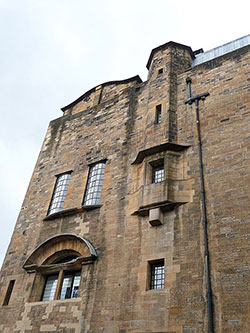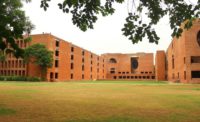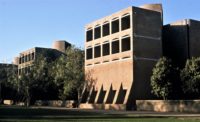In the early hours of Saturday, June 16, I turned on the news and saw those horrendous images of the Glasgow School of Art going up in flames yet again. It was like a bad dream: a glowing orange inferno caught live on mobile phones. It brought back memories of the fire four years ago which destroyed the most beautiful space in the building, the Library, one of the greatest rooms in the entire history of architecture. But this time the damage has been more far reaching. The building was undergoing restoration, but now the entire interior has been gutted from one end to the other. All that remains is the masonry shell and this will have been dangerously damaged by the very high temperatures. In reality, I fear that this masterpiece is gone for ever.
I am devastated by this loss. The Glasgow School of Art was like an old friend and every time I visited it, I discovered a new dimension of the work itself and of architecture in general. The Library was an inspiration: the abstraction of a woodland clearing with something of the character of a Japanese temple. The exterior of the west wing was a masterpiece of ambiguities between figure and ground, space and mass. Charles Rennie Mackintosh's magisterial work was in and of itself a teaching building: it taught students to see, to experience space and light, to feel textures, colors and materials. It touched the mind and the senses of all who passed through. It rested in memory. This was high architecture but it was somehow casual and convivial. It encouraged the mess of creation in its studios and promoted the mixing of people on its landings and stairs. It became a collective landmark, but only after decades of neglect during the years of Glasgow's decline.
In 2009, when the Glasgow School of Art celebrated its centenary, I delivered the keynote address, titled “Materials of the Imagination." I took the long historical view. This was one of those works that escape all stylistic categories. Its importance transcends local Scottish, British or even modern architectural agendas: it is, or was, a major universal creation, a part of human patrimony. There has been no work in the British Isles since to touch it, although there have been remarkable buildings influenced indirectly by it, such as James Stirling's Leicester Engineering or Denys Lasdun's masterpeice, the Royal College of Physicians, both of the early sixties.

When I included The Glasgow School of Art in my book Modern Architecture Since 1900 (1982) I refused to see it as Nikolaus Pevsner did as a mere 'pioneer of modern design'. Like all unique masterpieces, the building does not fit a single chronological slot. Its contemporary cousins may have been works by Josef Hoffmann in Vienna and Frank Lloyd Wright in the American mid-west, but it also contained many historical echoes. In British architecture one has to go back to John Soane or Nicholas Hawksmoor to find anything of this astounding originality and quality; it is an inventiveness rooted in a deep sense of the history of architecture. Mackintosh fused a unity out of a wide range of sources from Scottish Baronial castles, to Japanese architecture, to North American and British industrial buildings, to Michelangelo, but he transformed these into something fresh and new.
The School of Art was “timeless but of its time.” In it, Mackintosh crystallized the energies of industrialism at a peak moment when Glasgow was a powerhouse of the Empire, linked to the wide world through ship building, steamship routes and international trade; at the same time he hankered after myths of Scottish identity in his transformation of the rural vernacular of the heartlands and his mystical abstraction of “nature.”
The Centennial events of December 2009 brought together students from all over the world with major figures of Scottish and international architecture. Somehow the building looked at its best in the frost and mist of the Glasgow winter, especially at dusk when the lights inside conferred an oriental atmosphere like a lantern. The students interviewed me in the warmth of the timber library with its crystalline abstractions of oriel windows, and I referred to it as a quarry of inspirations for the future! But a shadow was cast in the ensuing years by Steven Holl's over-scaled and hostile annex across the road, a cold glass refrigerator of a building without sensitivity to its vastly superior historical neighbor.
But worse was to follow: in the summer of 2014 there was the first fire, apparently started when a student project went wrong and a projector caught fire under the influence of a chemical foam. Such materials had no place in wooden parts of the old building at all, especially when less inflammatory studio spaces for experimental work were available elsewhere. In an article about this tragedy in the Architectural Review (July 2014) entitled “Burning Questions” I wondered, was this just an accident? Was there responsibility at some level? Why had the sprinkler system in the old building not been completed when millions had been spent on the annex? Quickly such questions were smothered under political rhetoric and the promise of major public funding to restore the building, as if that were really possible. The best one could hope for was a competent pastiche of the Library and other damaged areas.
The sophisticated work of restoration was well advanced when the whole building went up in smoke the other night. Once again the heroic firemen did all they could to save a work much loved by Glaswegians and by people all over the world. Is anyone to blame? Or is this just to be called another "accident"? Reports are emerging that a sprinkler system was partly installed but not yet functioning, almost a repeat of the first fire of 2014; that no alarms went off and that it was bystanders who first saw flames leaping out of the roof. Temporary fire protection systems for restoration sites are easily available but in this case it seems that none were installed. It is important to establish precisely how, when and where the fire got going. There should be a full public inquiry but already there are politicians denying the need for this. What do they wish to hide? As for Mackintosh's majestic masterpiece the Glasgow School of Art, I fear that this time it has left this earth forever more, body and soul.
Text copyright: William J.R. Curtis, 18th June 2018
William J.R Curtis is an award-winning historian, critic, artist and photographer. His best known books are Modern Architecture Since 1900 and Le Corbusier Ideas and Forms. and he contributes regularly to international journals. In 2015 there was a retrospective of his artistic work in the Palace of Carlos V in the Alhambra. He lives in rural France.
For more on the Glasgow School of Art by William Curtis, see the following links:




Post a comment to this article
Report Abusive Comment